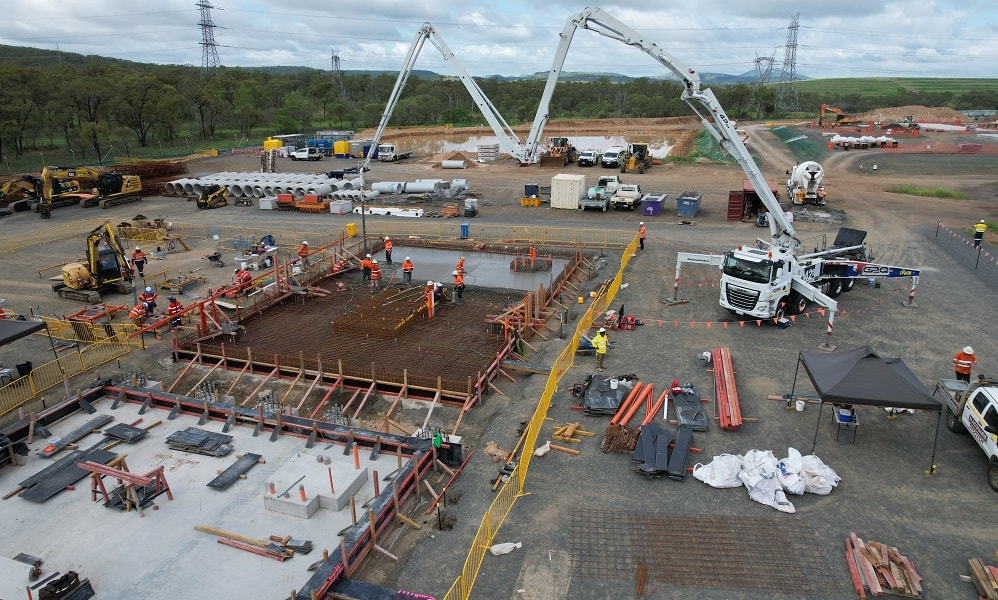Breaking Barriers: Battery’s innovative use of Stanwell Power Station fly ash
Breaking Barriers: Battery’s innovative use of Stanwell Power Station fly ash

Stanwell’s 300 MW Battery is set to do more than deliver reliable, affordable and secure electricity; it’s also literally laying the foundation for sustainable construction practices, further showcasing Stanwell Power Station’s circular economy in action.
In addition to its energy contributions, the project is using sustainable concrete in the 324 slabs that support, protect, and insulate each 38-tonne Tesla Megapack 2XL lithium-ion unit.
A total of 7,433m3 of concrete has been poured into the slabs, containing 1,100 tonnes of fly ash from Stanwell Power Station (SPS). Fly ash is a fine, powdery material produced as a byproduct of burning pulverised coal in power stations.
By incorporating a range of 25 – 50% fly ash in the design for all concrete mixes, the project conserved natural resources, lowered environmental impact and improved the concrete durability.
While the concrete slabs play a supporting role to the Megapack units, it’s crucial one, nonetheless. Acting as silent guardians, they prevent shifting or settling, ensuring the proper alignment and performance of the battery.
Additionally, concrete’s non-combustible nature acts as a fire barrier, helping contain thermal runaway events and electrical fires while buffering ground temperature fluctuations. Given these reasons, the quality and quantity of concrete could not be compromised.
In Queensland, it’s standard practice to use fly ash as a supplementary cementitious material (SCM) in concrete. Stanwell is committed to its circular economic approach by using SPS-produced fly ash to reduce emissions and on-site storage requirements.
Stanwell Power Station recently used SPS fly ash for a concrete slab for a large shed to house mobile plant and grounds maintenance equipment.
Early engagement with Stanwell’s procurement team mapped pathways to using SPS fly ash, which complies with industry standards (AS/NZS 3582.1:2016 Supplementary cementitious materials Part 1: Fly ash.)
Early research highlighted three main roadblocks:
SPS fly ash is sold and transported out of the region
Local concrete suppliers rely on fly ash from other generators.
Suppliers are reluctant to alter proven concrete mixes with fly ash from a different source.
Collaboration between Stanwell Corporation, principal contractor Yurika, and local industry identified a local batching plant Regional Group within 15km of SPS and the Stanwell Battery project site, reducing project and transport-associated emissions.
Stanwell’s Coal Combustion Products division has worked in partnership with Stanwell Procurement to ensure contracts require the assessment of SPS fly ash and bottom ash for use in internal projects at every opportunity and identify the pathways to certified SPS fly ash to overcome any roadblocks.
Approximately 55 per cent of the CO2 emissions of the cement and concrete sector in Australia originate from limestone calcination. Twenty six per cent are identified as fuel-based emissions, 12 per cent from electrical energy usage and another seven per cent indirect emissions are attributed to the transport of cement and concrete to the customer.
By incorporating SPS produced fly ash in the Stanwell Battery project, we took an authentic step towards reducing the project’s carbon footprint -laying sustainable foundations for energy’s future.
Subscribe to our newsletter
STANWELL SPARK
Stay up to date with quarterly news from Stanwell, delivered straight to your inbox. Learn more about our projects, partnerships and how we're delivering affordable, reliable and secure electricity for Queensland.